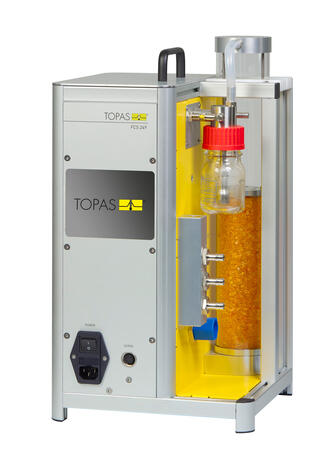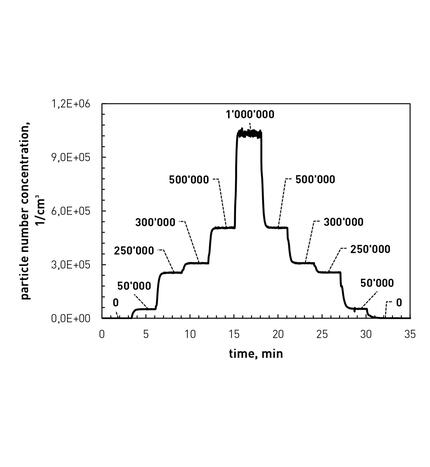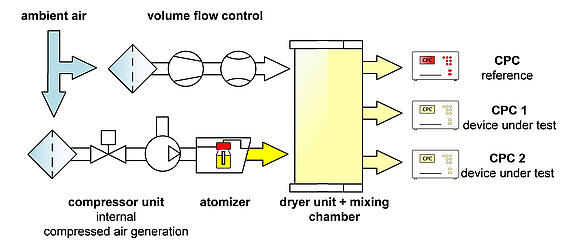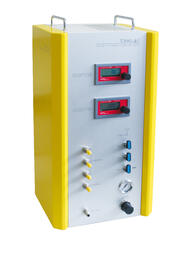FCS 249 Field Calibration System
FCS 249 Field Calibration System for aerosol generation from liquids, best for calibration of condensation particle counters and electrical aerosol monitors
The FCS 249 is a mobile system for the defined generation of reference and test aerosols, which can be varied with respect to the particle number concentration in a wide working range.
In particular, the FCS 249 is suitable for the validation of condensation particle counters (CPC) or electrical aerosol monitors, which are applied for the particle number concentration measurement in exhaust gases of vehicles according to the "AU-Geräte Kalibrierrichtlinie (German exhaust emission test equipment calibration guideline)".
Standards
STV 23/7355.2/2
VDI 3491-2
DIN CEN/TS 17660-2
DIN CEN/TS 18086
Benefits
- complies with all NaCl test aerosol requirements of the German exhaust emission test equipment calibration guideline
- suitable for use in harsh workshop conditions
- suitable for commercial low-concentration NaCl solutions
- mobile system (portable, no compressed air required, power supply needed)
- reactionless aerosol sampling
- 7 via touch screen adjustable points of particle concentration (with trim function)
Applications
- calibration and validation of aerosol measuring devices
- comparative measurements of particle counting devices for periodical technical inspection of vehicles (PTI)
- validation of mobile measuring devices (PEMS - portable emission measurement system) for exhaust gas testing in road traffic
The FCS 249 is a combination of aerosol generator, volume flow unit, drying unit and distributor. Schematic depiction of the functional principle of FCS 249 (DUT – device under test). When producing test aerosols from aqueous solutions, initially a droplet aerosol is generated via a two-substance nozzle. Subsequently, this is passed through a dry atmosphere, which removes the moisture from the streaming aerosol by diffusion. In the case of salt solutions, an undisturbed, homogeneous crystallisation is thereby ensured, leading to the formation of compact, completely dried salt particles.
| Parameter title | Unit | Value |
|---|---|---|
| setting parameter | 1/cm³ | particle number concentration |
| setting range | 1/cm³ | 0 ... 10⁶ (for aqueous 0,9 wt.-% NaCl solution) |
| setting resolution | - | 7 concentration stages |
| aerosol, volumetric flow rate | L/min | 20 |
| operating medium, aerosol substance - filling volume | mL | 40 ... 80 |
| power supply | - | 230 V AC or 110 V AC (specified at order), 0,34 A, 50/60 Hz |
| hose connector, outlet | mm | Ø 10 (3 ports) |
| power consumption | W | max. 75 |
| noise emission | dB(A) | max. 59,3 |
| environmental condition, max. counterpressure | kPa | 20 |
| dimensions (w × h × d) | mm | 260 × 480 × 250 |
| weight | kg | 11,0 |
-
Vasilatou K., Wälchli C., Auderset K., Burtscher H., Hammer T., Giechaskiel B. and Melas A. Effects of the test aerosol on the performance of periodic technical inspection particle counters Journal of Aerosol Science 172 (2023) 0, 1 - 14
dx.doi.org/10.1016/j.jaerosci.2023.106182 -
Melas A., Vasilatou K., Suarez-Bertoa R. and Giechaskiel B. Laboratory measurements with solid particle number instruments designed for periodic technical inspection (PTI) of vehicles Measurement 215 (2023) 0, 1 - 11
dx.doi.org/10.1016/j.measurement.2023.112839 -
Giechaskiel B. and Melas A. Impact of material on response and calibration of particle number systems. Atmosphere 13 (2022) 11, 1 - 17
dx.doi.org/10.3390/atmos13111770 -
Giechaskiel B. and Melas A. Comparison of particle sizers and counters with soot-like, salt, and silver particles. Atmosphere 13 (2022) 10, 1 - 20
dx.doi.org/10.3390/atmos13101675 -
Göhler D., Oelschlägel K., Hillemann L. and Giger-Pabst U. Characterisation of size-selective aerosol particle deposition in porcine pneumoperitoneum 11th International Aerosol Conference (IAC 2022) 0 (2022) 0,
dx.doi.org/10.13140/RG.2.2.33441.89446






